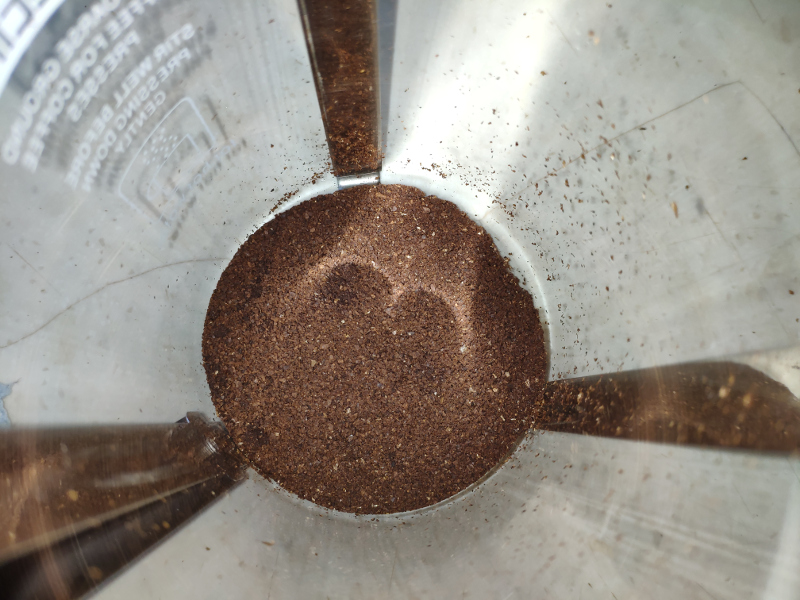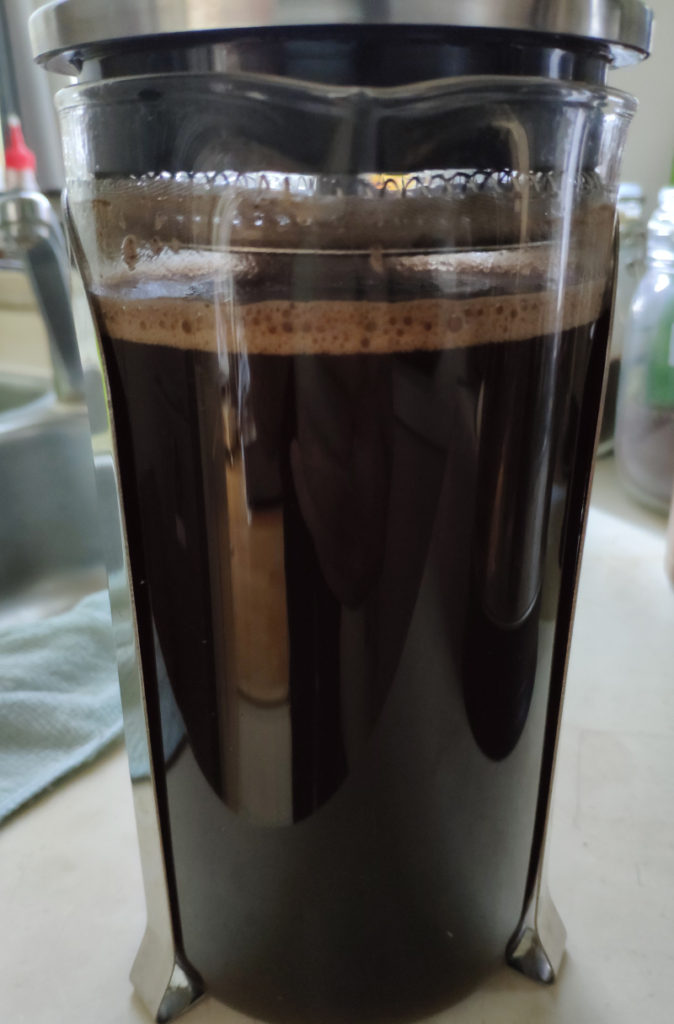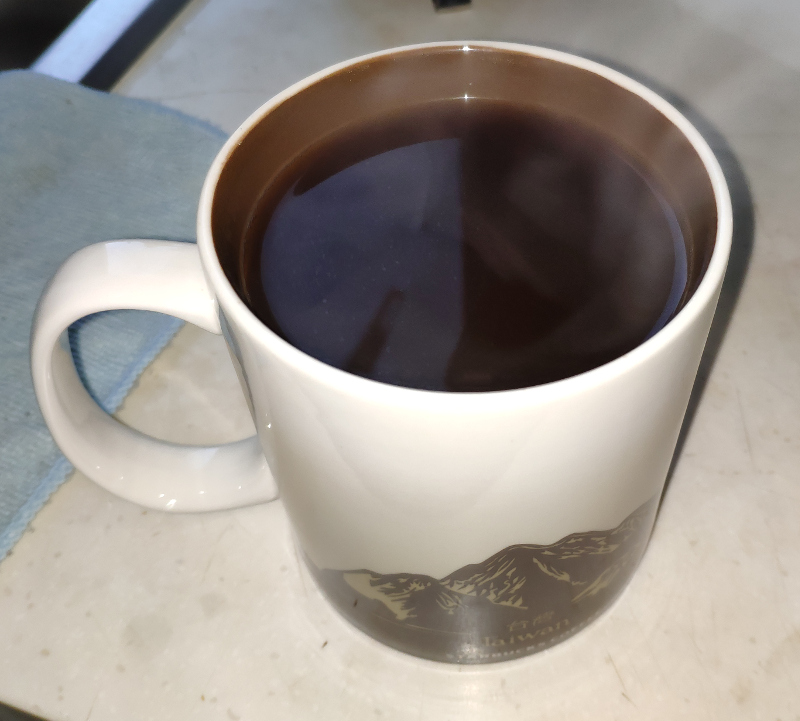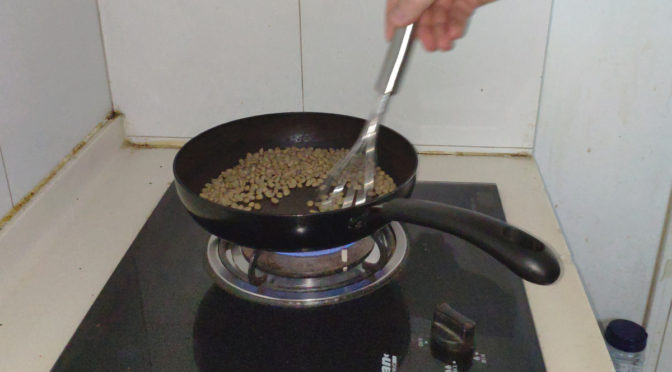I was nervous, I wasn’t sure what to expect. Here I was holding a bag of green coffee beans, noticing how tiny they looked in comparison to roasted beans.
This is it? I thought. Just put the beans in the pan and fry them? No ceremony?
I kind of had the feeling that this is very similar to the first of of other experiences in life, you mean, you just do it this way? And then, all too soon, it’s over.
But, that’s what I was told about roasting coffee. There isn’t much to it: just put the beans in, stir them around, and then remove the chaff after. That’s it.
Alright, well, let’s give this a go.
There are a few things you need to roast your own beans:
- Proper ventilation for your roasting area
- A colander or sift of some sort (to remove the chaff after roasting)
- A second pan or baking tray to cool the beans on
- A skillet
- A whisk
- A timer
And we start…
I decided to do what I thought was four days worth of coffee, that is, two tablespoons per day which should make four pots of coffee in my french press as they say. If I screwed up, then I could either drink it as is or throw them out. I still have another 900g to go.
Turn the heater on to heat the pan a little before putting the beans in.
Start the timer.
Put your beans in.
And start stirring. Constantly.
You don’t need to watch your timer but it helps in gauging how far long you should be in the process. Roughly, 4-5 minutes is a light roast, 6-7 minutes is a medium roast, 8-10 minutes is a dark, and 11-12 would be an espresso roast. The beans will start to crack, much like popcorn, and that’s how you’ll know how far along you are in your roast. Five minutes will be your first crack, eight minutes your second crack.
I got a little bit anxious and became almost hyperaware: Okay, first crack! The FIRST CRACK HAS BEEN HEARD.
Watch the timer,
keep stirring,
getting smokey in here, should’ve opened all the windows. And turn the oven fan on.
The beans start turning a yellow-blond colour. It’s here you have your first option to stop the roast. As I understand, there are basically four types of roast you can get from any one bean, though all can be modified with varying temperatures:
Light roast / blond – Yellow-gold beans, hardly the dark brown of many other roasted beans. This type of roast will be lighter in colour and will have more caffeine. You can take the beans off of the pan after the first sign of a crack, around minute five.
Medium roast – First crack is completely finished. This should happen around minute seven. This will also have plenty of caffeine in it but will have a bit more of a “darker”, cooked taste. This will be your “normal” coffee that you’re most likely to be familiar with.
Dark roast – Second crack is completed, around minute ten. After this, to save from burning the beans, you should remove them. Some say there will be less caffeine, others say there won’t be a difference in caffeine content, but this type of roast will have that “burnt” taste that will put some people off.
Espresso – About a minute after the second crack, this is a thoroughly fried bean and will be the darkest or heaviest flavour of them all. It’s also at risk of being overcooked and thus burned, so you want to be careful.
It’s at this point you might wonder what all the fuss is about in terms of roast type. I should mention the health benefits of effects of each roast because they seem to be of some concern. There are two things that affect your body as it consumes coffee:
The first is the oil of the bean. The beans I bought weren’t very oily after roasting (I was surprised) but you could still see a thin film of oil on the top of the coffee once poured into the cup. The oil has cholesterol which, as research has shown, contributes to plaque build up in your veins (which can be offset by eating other foods, such as flax seeds). You can also partially remove this oil by using a paper filter, but, in doing so, you are slightly (very slightly) altering the natural taste of the coffee.
The second are the chemicals produced and given off during the roasting process. These include the smoke itself from the roast process and, once roasted, the compound acrylamide which forms when the sugars and what not of a bean are heated up. Acrylamide has been shown to cause cancer in animals and, in high doses, is harmful to humans.
Sounds scary, right?
But let’s keep a couple of things in mind which will then lead to the taste of my first cup of own-roasted coffee.
First, cholesterol is found in a lot of foods so this is nothing new. You can mitigate its effects by restraining how the amount of coffee you consume and, more importantly, offset the negative effects by consuming foods that help remove it from the body (such as the flax seeds mentioned above).
Second, I don’t think it requires too much explaining that inhaling smoke can give you some breathing problems. It doesn’t matter what smoke it is, tobacco, marijuana, coffee, inhaling smoke, especially in large and continuous amounts, is not good for our bodies. So, how to fix? Wear a mask (so popular these days) and ventilate the area you’re roasting in.
And so, the roasting continued…
After roasting for ten minutes and turning the heat off, I realized I hadn’t set up my colander to shake the chaff off of the beans. I think this contributed to a slight over-roast for what I was intending (a dark roast, but not going for espresso) since the beans were still in contact with the hot pan. It only took a minute to get the colander so I’m not entirely sure if it was a big deal.
Either way, I dumped the beans into the colander and sift through them to remove the flakes of coffee bean. This took another minute or so but was neat to see how much the beans had changed colour from their original green bean state.
After that, I dumped the beans into an air-tight jar (which can also be a hazard but is mitigated by opening the jar and scooping out some beans… which you will be doing in order to drink your coffee anyway, right?) and scooped out two tablespoons of beans. I found it a bit strange that the coffee beans didn’t give off much of an aroma in the jar itself. Not sure why.
(***There is a danger of the coffee exploding in its storage container, though I’m not sure how much of an issue this is. Coffee beans contain some carbon dioxide which is released when the beans are roasted and which contributes to that coffee fragrance we love so much. As this carbon dioxide is left off, if it’s kept in an enclosed container, it runs the risk of breaking through the material. This is why you’re supposed to “de-gas” your coffee, which basically means exposing the beans to the air for a bit before storing them.)
Looking at the amount of roasted coffee, I wonder if the original “four day’s worth of coffee” might be more than that. We’ll see how this turns out.
Now came the whole point of the procedure: to have my cup of coffee. I started at 9 am and now it was already 9.35 am, we’re getting a little needy here. I have back up coffee from a package just in case this doesn’t work out.
Remember, the beans didn’t give off of an aroma in the jar, but my apartment did reek of smoke. Once I ground up the beans, however, BAM! The aromas exploded out. And no, I don’t mean the jar exploded. I mean that’s when you could really smell the fragrance of the coffee.

Into the press the ground beans went and in went the just-off boiling-temperature hot water. More aromas! And look at the foam on that thing! It’s a good centimeter thick!

(The foam of coffee is similar to the head of a beer when it is poured. As soon as the water hits the ground beans it begins to release carbon dioxide which causes this foaming action. If you normally use a drip machine you won’t get to see the foam form when the water hits the beans since it happens in an enclosed space. Most store-bought coffees, if ground fresh at home and used right away, produce a foam layer of a few milimeters, even if it’s freshly-ground Starbucks coffee. Hence my surprise at how much foam was produced by this bean.)
I’ve started grinding my beans to a fine grind even though I use a french press due to time constraints. At work I’m not supposed to fuss over my coffee so I needed a method to make it quick but still get the flavour. Using a medium-fine grind, I can let the coffee sit for 2-3 minutes and then pour it out. Also, I often transfer the coffee entirely out of the french press both because the longer the time the water is touching the grounds the darker and heavier the flavour will become. And the more oils will be extracted thus adding to more cholesterol. So, once the time has been met, I pour it all into a cup and a flask to keep hot.
And that’s just what I did. The first cup poured out, very hot, owie, take care! But, in a tentative, careful sip…

WOW.
THAT’S WHY WE DRINK COFFEE.
THAT’S WHAT COFFEE IS SUPPOSED TO TASTE LIKE.
THAT’S WHY THE GOATS WERE EATING THE BERRIES.
THAT. IS. A CUP. OF COFFEE.
HF I says to myself. No wonder this beverage it so popular. No wonder so many people drink coffee. No wonder the people who first started drinking coffee told others about it. No wonder the people who were told by the others who had first started drinking coffee then went on to start businesses that mass produced and exported coffee all over the world.
To put it simply: it was a really good cup of coffee.
And, as I was instructed to do by my colleague (who originally gave me the idea of roasting my own coffee) and by numerous internet searches, I kept notes on the flavour as I had my first cup:
- smooth
- chocolately
- no real aftertaste
- no caffeine jolt
Then throughout the rest of the pot and on the experience as a whole:
It was pretty good, drinkable, like sit there and think: I made that. No caffeine jolt as far as I could tell which made me think of making a second pot later on (but didn’t). The coffee aged well over time, as in it didn’t get any more bitter the longer it sat. Prep time was 10-11 mins on the pan which might have been too long as I hadn’t prepared the sift to separate the bean from the chaff. Ten minutes leads to the second crack which is the sign of a darker roast (and less caffeine) so I wonder if in total frying time it was too long. Total prep time from roast to cup was about 20-25 minutes. Didn’t take as much time as I thought it would and am looking at other ways to roast more. I also need to better ventilate during roasting cause now my whole apartment reeks of smoke.
I got the beans online from Yunan, which is China’s coffee province. The taste profile says 8 overall so it shouldnt stand out in any one way, Ie, simply be more balanced. About 25$ for a kilo, but it might produce more than that after roasting.
As for the actual taste of the coffee, more chocolately than anything else and a bit nutty. Overall, very smooth.
I did end up making another half pot but used two tablespoons for the half pot just to see if it would change the jolt of caffeine. This pot had a stronger, heavier flavour, and a bit more caffeine, but a taste that said that there was a lot of coffee in one pot.
So, having roasted my first batch of coffee, would I do it again?
Yes, absolutely. One thought I had in my mind was that now I had an entire kilogram of coffee that I needed to roast each time I wanted a cup of coffee. I’m not against ordering more beans of a different variety (mine were from Yunnan from the 2020 crop year). Next, I went for a dark roast this time so next time I may go for a light roast which should give it more caffeine. Finally, if I ordered more coffees, I could then blend them and see how they complement each other.
And with the cost of green beans much cheaper than roasted coffee, for the same price of one bag of store bought coffee I could have four types of coffee beans. This is something to consider going forward.
Where to go from here?
I am thinking of buying a few more types of coffee to try out and other roasting methods:
- Light / blond roast
- Butter roast (Chinese / Vietnamese style, cook the beans with butter)
- Boil the beans first
- Espresso roast
- With star anansi
- Brown sugar?
- Maple sugar?
- Cinnamon
- Green bean coffee?
So there are a few things to try out with each bag of beans. The important thing to remember and to consider above all is the type of beans you buy. Certain regions of the world produce a certain type of coffee flavour and, following from that, some beans taste better with a certain type of roast rather than another. Although there is some science behind it, roasting coffee seems more like an art than anything else.
